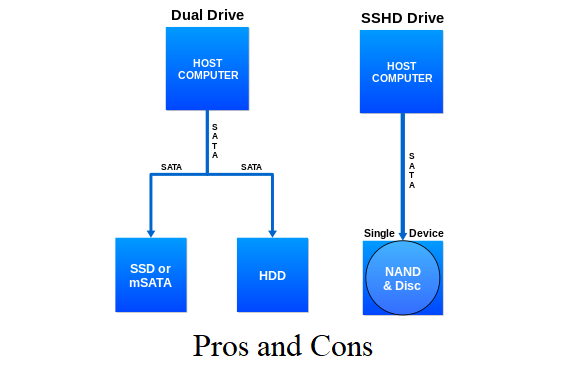Imagine a drive, best of both worlds. Inherited from both spinning hard drive and solid-state drive. The end product is a hybrid drive, better known as Solid State Hybrid Drive (SSHD). SSHD combines a smaller yet faster SSD with larger spinning hard drive soldered together into one device. The drive is controlled by the SSHD controller. An example of such drive is the Seagate SSHD. The sole purpose of hybrid drive technology to provide you with the best of both world option. The smaller but faster Solid-State Drive (SSD) can serve as boot device and bigger but slower Hard Disk Drive (HDD) can serve as storage media. Though SSHD pros and cons are not hidden from the world specially anything about it upgrading is talked for over a year now.
SSHD is similar to another technology, the dual-drive hybrid system. In dual-drive hybrid system, there is physically separate SSD and HDD present in the system configuration with data placement optimization performed either manually or automatically through operating system. In SSHD, SSD and HDD is present in the single piece of hardware, where data placement optimization is either done fully by the drive through SSHD controller or placement hints provided by the operating system.
Pros and Cons of SSHD

Though it may be advertised and marketed as best of both worlds, it might not hold true for every individual or every system. Let’s look at the SSHD pros and cons and decide for ourselves.
Pros of SSHD
- Faster: SSHD definitely will run faster than HDD. Due to the presence of SSD, if you have a particular pattern of storage or usage, the particular file can be cached. Next time when you access the file, you can see significant increase in speed.
- More capacity: With the SSD and HDD combined, you can definitely have more capacity than the SSDs in the market. It doesn’t tell though if it will have capacity larger than the current HDDs available.
- Single Drive: The SSHD appears as a single drive to the operating system. There is no need to manage two drives separately. There is also no need to choose between the drives for the storage of data.
- Fast boot up: Windows’s ReadyDrive driver will help your hybrid drive to store all the files your computer needs to boot up on the flash part of the SSHD. This helps to decrease the boot time significantly.
- Less power use: As opposed to the traditional HDDs, SSHD uses less power to operate the drive which definitely a pro for a laptop. SSHD too has a spinning part, but once the copying work is done, the power saver mode can be attained.
- Cheaper: This device is definitely cheaper than the SSDs, but not than the HDDs. It’s kind of falls in between the two drive options. While being cheap can be perk for some, there is no doubt about compromise made.
Also Read: SSD Pros and Cons
Cons of SSHD
- Failure: If either of the part of the drive fails, the whole system is compromised and cannot boot. The entire device will fail, keeping you totally confused about what might have gone wrong.
- Data recovery: Data recovery process was difficult on the first place, with the hybrid technology, its even harder. There is no either SDD or HDD option for recovery, both drives need to be put under recovery.
- Reliability: While the SSDs start losing bit after few 1000s of PE cycles, and HDD remains active longer, the reliability of SSHD is unknown. It may or may not last longer because these devices have not been in general circulation for more years.
- Early extinction: While the SSHD technology is fairly new, it is sure to extinct sooner according to some experts. With the SSDs prices decreasing every day and larger storage option like HDD available at lot cheaper price, SSHD technology doesn’t seem to be successful enough to live an impact upon the market.
- Very little control: SSHD controller controls the working of the SSHD automatically. So, this implies that you won’t be able to determine what to put where in the drive. Very little control makes it harder for the optimization of the drive.
Conclusion
As a conclusion, SSHD technology doesn’t seem to stay as the HDD did and SSD is trying to do. With very little room for improvement and optimization, it will not be preferred by huge number of individuals out there who like taking command over their system and not being commanded. So, though it is an option comprising both the SSD and HDD, it is definitely not the best of both worlds. These are few unbiased SSHD pros and cons discussed in the post.
